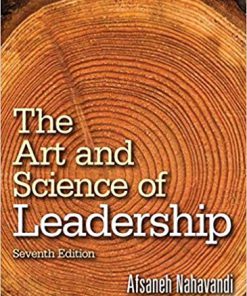The Leadership Experience 7th Edition (eBook PDF)
$50.00 Original price was: $50.00.$35.00Current price is: $35.00.
The Leadership Experience 7th Edition (eBook PDF) – Instant Download
The Leadership Experience 7th Edition (eBook PDF) – Digital Ebook – Instant Delivery Download

- ISBN-10 : 133710227X
- ISBN-13 : 978-1337102278
- Author: Richard L. Daft
Master the critical leadership skills and solid understanding of theory needed to become an effective business leader in today’s turbulent times with THE LEADERSHIP EXPERIENCE, 7E. Acclaimed author Richard Daft helps you explore the latest thinking in leadership theory and contemporary practices at work within organizations throughout the world. You’ll examine emerging topics, including enhancement of emotional intelligence, leadership vision and courage, and leadership of virtual teams, and you’ll connect those topics to recent world events such as ethical scandals, leader successes and mistakes, and political turmoil. Packed with memorable examples and unique insights into actual leadership decisions, this full-color text includes crisp, clear visuals to reinforce the book’s engaging presentation. This edition’s proven applications, specifically designed for today’s leadership theory and applications course, and a solid foundation grounded in established scholarly research make the topic of leadership come alive. In addition, THE LEADERSHIP EXPERIENCE is available with MindTap, an integrated text and online learning solution that enhances understanding of course content and offers opportunities to extend learning.
Part 1: Introduction to Leadership
Chapter 1: What Does It Mean to Be a Leader?
1.1 Why We Need Leadership
1.2 The New Reality for Leaders
1.3 How Leadership Differs from Management
1.4 Evolving Theories of Leadership
1.5 Leadership Can Be Learned
1.6 Mastering the Art and Science of Leadership
1.7 Organization of This Book
Leadership Essentials
Discussion Questions
Leadership at Work
Leadership Development: Cases for Analysis
References
Part 2: Research Perspectives on Leadership
Chapter 2: Traits, Behaviors, and Relationships
2.1 The Trait Approach
2.2 Know Your Strengths
2.3 Behavior Approaches
2.4 Individualized Leadership
2.5 Entrepreneurial Traits and Behaviors
Leadership Essentials
Discussion Questions
Leadership at Work
Leadership Development: Cases for Analysis
References
Chapter 3: Contingency Approaches to Leadership
3.1 The Contingency Approach
3.2 Hersey and Blanchard’s Situational Theory
3.3 Fiedler’s Contingency Model
3.4 Path-Goal Theory
3.5 The Vroom-Jago Contingency Model
3.6 Substitutes for Leadership
Leadership Essentials
Discussion Questions
Leadership at Work
Leadership Development: Cases for Analysis
References
Part 3: The Personal Side of Leadership
Chapter 4: The Leader as an Individual
4.1 The Secret Ingredient for Leadership Success
4.2 Personality and Leadership
4.3 Values and Attitudes
4.4 Social Perception and Attributions
4.5 Cognitive Differences
4.6 Working with Different Personality Types
Leadership Essentials
Discussion Questions
Leadership at Work
Leadership Development: Cases for Analysis
References
Chapter 5: Leadership Mind and Emotion
5.1 Leading with Head and Heart
5.2 Mental Models
5.3 Developing a Leader’s Mind
5.4 Emotional Intelligence
5.5 Leading with Love versus Leading with Fear
Leadership Essentials
Discussion Questions
Leadership at Work
Leadership Development: Cases for Analysis
References
Chapter 6: Courage and Moral Leadership
6.1 Moral Leadership Today
6.2 Acting Like a Moral Leader
6.3 Becoming a Moral Leader
6.4 Servant Leadership
6.5 Leading with Courage
Leadership Essentials
Discussion Questions
Leadership at Work
Leadership Development: Cases for Analysis
References
Chapter 7: Followership
7.1 The Art of Followership
7.2 What Your Leader Wants from You
7.3 Styles of Followership
7.4 Strategies for Managing Up
7.5 The Power and Courage to Manage Up
7.6 What Followers Want from Leaders
Leadership Essentials
Discussion Questions
Leadership at Work
Leadership Development: Cases for Analysis
References
Part 4: The Leader as a Relationship Builder
Chapter 8: Motivation and Empowerment
8.1 Leadership and Motivation
8.2 Needs-Based Theories of Motivation
8.3 Other Motivation Theories
8.4 Empowering People to Meet Higher Needs
8.5 Giving Meaning to Work through Engagement
8.6 New Ideas for Motivation
Leadership Essentials
Discussion Questions
Leadership at Work
Leadership Development: Cases for Analysis
References
Chapter 9: Leadership Communication
9.1 How Leaders Communicate
9.2 Leading Strategic Conversations
9.3 Communicating to Persuade and Influence
9.4 Selecting the Correct Communication Channel
9.5 Nonverbal Communication
9.6 Current Communication Challenges
Leadership Essentials
Discussion Questions
Leadership at Work
Leadership Development: Cases for Analysis
References
Chapter 10: Leading Teams
10.1 The Value of Teams
10.2 The Dilemma for Team Members
10.3 Leading a Team to High Performance
10.4 Team Processes
10.5 What Team Members Must Contribute
10.6 Leading a Virtual Team
10.7 Handling Team Conflict
Leadership Essentials
Discussion Questions
Leadership at Work
Leadership Development: Cases for Analysis
References
Chapter 11: Developing Leadership Diversity
11.1 Leading People Who Aren’t Like You
11.2 Diversity Today
11.3 Challenges Minorities Fac
11.4 Ways Women Lead
11.5 Global Diversity
11.6 Becoming an Inclusive Leader
11.7 Ways to Encourage the Advancement of Women and Minorities
Leadership Essentials
Discussion Questions
Leadership at Work
Leadership Development: Cases for Analysis
References
Chapter 12: Leadership Power and Influence
12.1 Four Kinds of Influential Leadership
12.2 Using Hard versus Soft Power
12.3 Increasing Power through Political Activity
12.4 Don’t Take Power Personally
Leadership Essentials
Discussion Questions
Leadership at Work
Leadership Development: Cases for Analysis
References
Part 5: The Leader as a Social Architect
Chapter 13: Creating Vision and Strategic Direction
13.1 The Leader’s Job: Looking Forward
13.2 Leadership Vision
13.3 Mission
13.4 The Leader as Strategist-in-Chief
Leadership Essentials
Discussion Questions
Leadership at Work
Leadership Development: Cases for Analysis
References
Chapter 14: Shaping Culture and Values
14.1 Organizational Culture
14.2 Culture Strength, Responsiveness, and Performance
14.3 Cultural Leadership
14.4 The Competing Values Approach to Shaping Culture
14.5 Ethical Values in Organizations
14.6 Values-Based Leadership
Leadership Essentials
Discussion Questions
Leadership at Work
Leadership Development: Cases for Analysis
References
Chapter 15: Leading Change
15.1 Leadership Means Leading Change
15.2 A Framework for Change
15.3 Using Appreciative Inquiry
15.4 Leading Creativity for Change
15.5 Implementing Change
Leadership Essentials
Discussion Questions
Leadership at Work
Leadership Development: Cases for Analysis
References
Name Index
Index of Organizations
Subject Index
You may also like…
Business & Economics - Management & Leadership
The Leadership Experience, 8e 8th Edition Richard L. Daft – eBook PDF











